| dc.description.abstract | This study set out to establish the factors that influence contraceptive use among
the youth in Kenya and recommend possible ways through which contraceptive
use among the youth can be promoted to achieve the intended goals of
controlling fertility in Kenya.
The study uses the 2003 Kenya Demographic and Health Survey (KDHS) data.
The study analyses 2132 female respondents aged 15 to 24 years. The statistical
tool used to analyze the data include percentages and cross-tabulation at the
bivariate level, while logistic regression was used to demonstrate the presence of
statistical association between ever use of contraception and selected intervening,
socio-economic, socio-cultural and demographic factors.
The key findings of the study as presented in chapter four show that most of the
variables used in the study affects contraceptive use among the youth in Kenya.
However, some variables are not significant in influencing contraceptive ever use
among the youth. Three models are used in the analysis, where the first model
controls for both demographic and intervening variables while the second model
controls for intervening variables only. In the third model, all variables for the
study are included and the results obtained are not different from the results
obtained when some variables are controlled for in the first and second models.
This show that demographic variables and intervening variables do not influence
the way socio-economic and socio-cultural variables affect contraceptive use
among the youth.
Also in the multivariate analysis finding show that Demographic factors and
socio-economic factors are significant whereas intervening and socio-cultural
factors are not significant in influencing contraceptive use among the youth.
The principal policy implication is to design communication strategies that will
reach the less privileged, rural and illiterate people who are by far the majority in
Kenya and who are les contraceptive users as compared to other groups. It is
recommended that school based dissemination of family planning information in
the context of family life education should be revamped.
In Kenya, family planning services are available in many hospitals, clinics, and
dispensaries. However these services are available only to married women
because the unmarried women fear from seeking for these services directly from
these clinics. Sexually active unmarried young people are therefore
disadvantaged as far as access to family planning services is concerned. This lack
of access promotes their inadequate use of family planning methods. Although
contraceptives use among unmarried young people has been highly criticized,
the government officials NGO's, community leaders, church leaders and parents
need to provide alternative solutions since knowledge and skills without access
to services are worthless (Bandura, 1992). Family planning services should be
made widely available and accessible to the young people.
The findings underscore the need for further studies in understanding further
specific factors affecting contraceptive use among different socio-cultural groups
among the youth. For instance what factors affect contraceptive use among the
poor young people in Kenya? The studies should further identity strategies and
interventions that can help increase contraceptive use within the different sociocultural groups. | |

